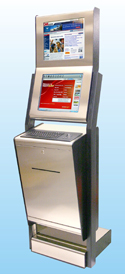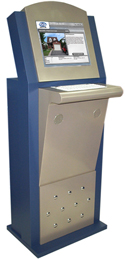Article
Building the perfect box: the future of enclosure design
If you want to start a heated discussion, ask a computer-lover which is better: a PC or a Mac. Ask a soft drink distributor how he feels about Coke versus Pepsi. Later this month, ask any hardcore basketball fan who they think is the best team in the NCAA. Or ask a kiosk enclosure manufacturer which material is best for the job.
March 16, 2005 by James Bickers — Editor, Networld Alliance
If you want to start a heated discussion, ask a computer-lover which is better: a PC or a Mac. Ask a soft drink distributor how he feels about Coke versus Pepsi. Later this month, ask any hardcore basketball fan who they think is the best team in the NCAA. Or ask a kiosk enclosure manufacturer which material is best for the job.
Well, perhaps that last one won't inspire the same level of white-hot passion that college basketball will, but it is a conversation that is taking place nonetheless. As new materials evolve, kiosk enclosures made from old warhorses like stainless steel and wood might become less and less prominent, giving way to new offerings like structural foam and proprietary materials.
A material for every need - and budget
But for now, those old standbys are still serving people well.
"The most cost effective choice is metal, since we have in-house engineering and fabrication capabilities," said Will Pymm, director of business development for Long Island-based RedyRef Products and Solutions. In addition to kiosks, RedyRef manufactures telephone booths and interactive building directories. Pymm says metal is such a good choice because it eliminates the need for painting and reduces the need for secondary finishing. "This has not changed much, although the raw price of stainless steel has increased significantly over the past few years," he added.
For the Ontario-based manufacturer and service provider G-NET IMKS, the materials of choice are steel and aluminum. "These materials are not only much more versatile than wood, but in many cases, lighter and thinner and more pliable, which allow for a more attractive design," said Shawn Gusz, chief executive officer for G-NET.
That said, Gusz acknowledges that wood is an attractive choice for the budget-conscious. "I would still say wood is the most cost effective," he said. "Wood kiosks are easily built with CNC routing machines and general labor. Making a metal kiosk look good requires special work in stamping, laser cutting, welding and powder coating. But in the end the design is much better and will probably last longer than its wooden counterpart."
 |
A modular metal design from RedyRef Products |
"When we need to do short run or low quantity, we use metals and wood," said Steve Giordano Jr., president and chief technical officer for the Virginia firm Lucidiom. "If we have the luxury of longer lead times and NRE dollars for the project, we prefer molded plastics. The overall price is better and the look is more uniform."
The future is fabricated
Irvine, Calif.-based manufacturer CeroView takes a number of different approaches to kiosk enclosure materials. In addition to standard choices like stainless steel and wood, they offer models crafted from glass and DuPont Corian, a versatile product often used for kitchen countertops. "In fact, we're the only kiosk enclosure manufacturer that has an all-glass kiosk," said Derek Fretheim, the company's CEO. He said CeroView is now offering structural foam and vacuum-formed plastic as possible choices.
"Traditionally, metal has been the most cost effective," Fretheim added. "However, with the constant increase in the prices of metal, plastic and structural foam are becoming more cost-effective."
Fretheim is bullish on emerging products like structural foam and plastics: They are very durable, inexpensive, and can easily be whipped into most any shape. He notes that upfront costs for dealing with such materials can be high, but can be recouped quickly for large projects. "The overall production costs outweigh the initial costs, specifically for larger rollouts of 500 or more kiosks," he said. CeroView also blends material types, building enclosures that combine structural foam and plastic with metal.
Products such as Corian hold great promise for kiosk enclosures, as well. Developed and manufactured by DuPont, Corian can be found in many homes in the form of sinks, vanities, countertops, bars and windows. It is durable, nonporous, can be refinished if it becomes marred or scratched, and can be cut, routed and sculpted just like wood.
Expert kiosk metallurgists needn't worry about the obsolescence of their wares, though. Demand for outdoor kiosks is high, according to Pymm, whose company recently filled an order for a custom outdoor enclosure for a government agency, with an eye toward many more. Outdoor kiosks necessitate a metal enclosure, preferably with a protective powder coated finish.
So don't write off those old standbys just yet.
The shape of things to come
Enclosure manufacturers not only concern themselves with the materials they will use; they also have to keep an eye on the aesthetics. Function might have trumped form at one time, but today's users need to be "wowed" in order to try something new.
"No one wants to use an old-looking, boxy machine that looks like it came from a bank in the 1980s," Gusz said. "Today, the material design is just as important as the function of the kiosk." Striking that balance between practicality and visual appeal is one of the ongoing challenges facing the kiosk designer.
"I see kiosk designs becoming increasingly modular," Pymm said. "RedyRef's theory is to build versatile kiosks, standard modular kiosks that can fit the needs of 80 percent of our customer applications."
Pymm says that a primary goal is to make upgrades and replacements quick and easy - and make them possible while the unit is still deployed. RedyRef's new models are designed with mounting provisions and hardware that allow new features to be added on the spot.
"This saves the customer money and gives the customer a sense of relief that he can always upgrade, to a printer for instance, if the application calls for it," he said. "We feel the modular design is extremely important in order to offer a competitively priced, high quality kiosk."
A modular approach makes sense not only from the standpoint of upgrades, but also for routine maintenance.
"Let's face it, a kiosk in a public environment is susceptible to vandalism and damage," Fretheim said. "If someone breaks the glass on a monitor and it takes a service technician an hour-and-a-half to replace it because they're weeding through a ton of cables or removing other components to get to the monitor, then that kiosk has been engineered poorly." CeroView's enclosures, he said, allow replacement of a monitor in less than 15 minutes.
According to Pymm, two different design trends are taking place at the same time: larger displays, made possible by decreasing display prices, coupled with overall designs that use smaller components and have a smaller footprint.
 |
G-NET's small-footprint KX1 enclosure model |
G-NET, for instance, works on squeezing out every bit of functionality from each square foot; their baseline model, the KX1, has a footprint of 22 inches by 20 inches. "We tend to offer slimmer, lower-profile kiosks since we deal with universal applications," Gusz said. "Our kiosks are usually placed in malls, retail stores and other high-traffic venues. The attractiveness and classy design of our kiosks is vital to attracting users to them."
To Fretheim, the best use of kiosk size doesn't come from shrinking the machine's footprint, but rather increasing the number of people that can use it.
"I think the future is in multiple users at a kiosk," he said, "either triangular shaped or back-to-back systems." CeroView boasts several multiple-user designs that have a footprint of less than nine square feet. "I think clients will look at this more and more as they see the benefit in assisting multiple customers."
Turning heads, stopping feet
Then, of course, there is that nebulous and elusive "wow factor." A shopper walking through a mall or a retail space is being lured in every practical direction at once, dozens of signs, products and human beings competing for his or her attention. A kiosk needs something special in order to have a chance at gaining that attention.
"Kiosks have to be eye-catching, they have to be edgy, and they have to be user-friendly," Gusz said. "Half the battle in deploying a kiosk is actually attracting new users to it. Once you have them, it's the software design and function of the kiosk that will keep them there."
CeroView's Fretheim works from a triangular model for kiosk design, built around three important concepts: an aesthetically pleasing design, an engaging application and a solid, functionally engineered system. And he says that first one - the design of the enclosure itself - is the most important one, atop the triangle.
Fretheim says his company's designs are built with the "seven second rule" in mind - that is, you have a mere seven seconds to attract the attention of a passerby.
"If the kiosk is a box and is ugly, then you are not likely to attract the type of attention needed for kiosk use," he said. "People need to be engaged from the beginning and it is market-proven that an eye-catching design is better than a box."
Lucidiom's Giordano points out something that is all too easily forgotten in the race to make the slickest and most eye-catching design: Make sure your finished product fits aesthetically with the place it will call home.
"The design must fit the market," he said. "Any design must have a certain amount of flexibility built in. An ATM at the Ritz does not look like an ATM at 7-Eleven."






